Updated January 22, 2024
.NET Core PDF Library
IronPDF is available for Microsoft Windows .NET Framework 4.x, as well as a recent release for .NET Core 3.1, .NET latest version.
IronPDF for .NET Core is available through the NuGet official page IronPdf package
The current .NET Core release cross-platform supports Linux, Unix and macOS client operating systems as well as mono, MAUI, and Blazor.
Existing and new customers receive free upgrades to the .NET Core build of IronPDF within their existing Support & Upgrade coverage. This is provided with every commercial license. This ensures your investment in IronPDF is future-proofed.
Existing customers who wish to extend expired support & update cover can purchase an extension here.
IronPDF: A .NET PDF Library
IronPDF is a C# PDF library that can be used in .NET Core projects. It provides all the necessary APIs to manipulate PDF documents straightforwardly and intuitively. There are other PDF-generating libraries on the market, but this library has been designed as simply as possible to avoid confusion.
The main goal of this project is to provide a PDF library for .NET applications. It comes with many useful features, such as generating PDF files from HTML strings, converting PDFs to other formats, manipulating existing PDF documents, and generating PDF files directly from .NET Core projects. The IronPDF library also offers the ability to print PDF files with just a few lines of code. IronPDF can be used as a PDF converter. It can create multi-page spread tables using its accessible functions.
Let's begin using the IronPDF library in our project.
Create C# Project
The latest version of Visual Studio is recommended for creating this .NET project to ensure a smooth user experience. The IronPDF library is also compatible with a .NET Core project. The choice depends on the user, as the installation and use of IronPDF are identical across all .NET Frameworks. Follow the steps below to create a project in Visual Studio.
Start Visual Studio.
- Click on "Create a new project".
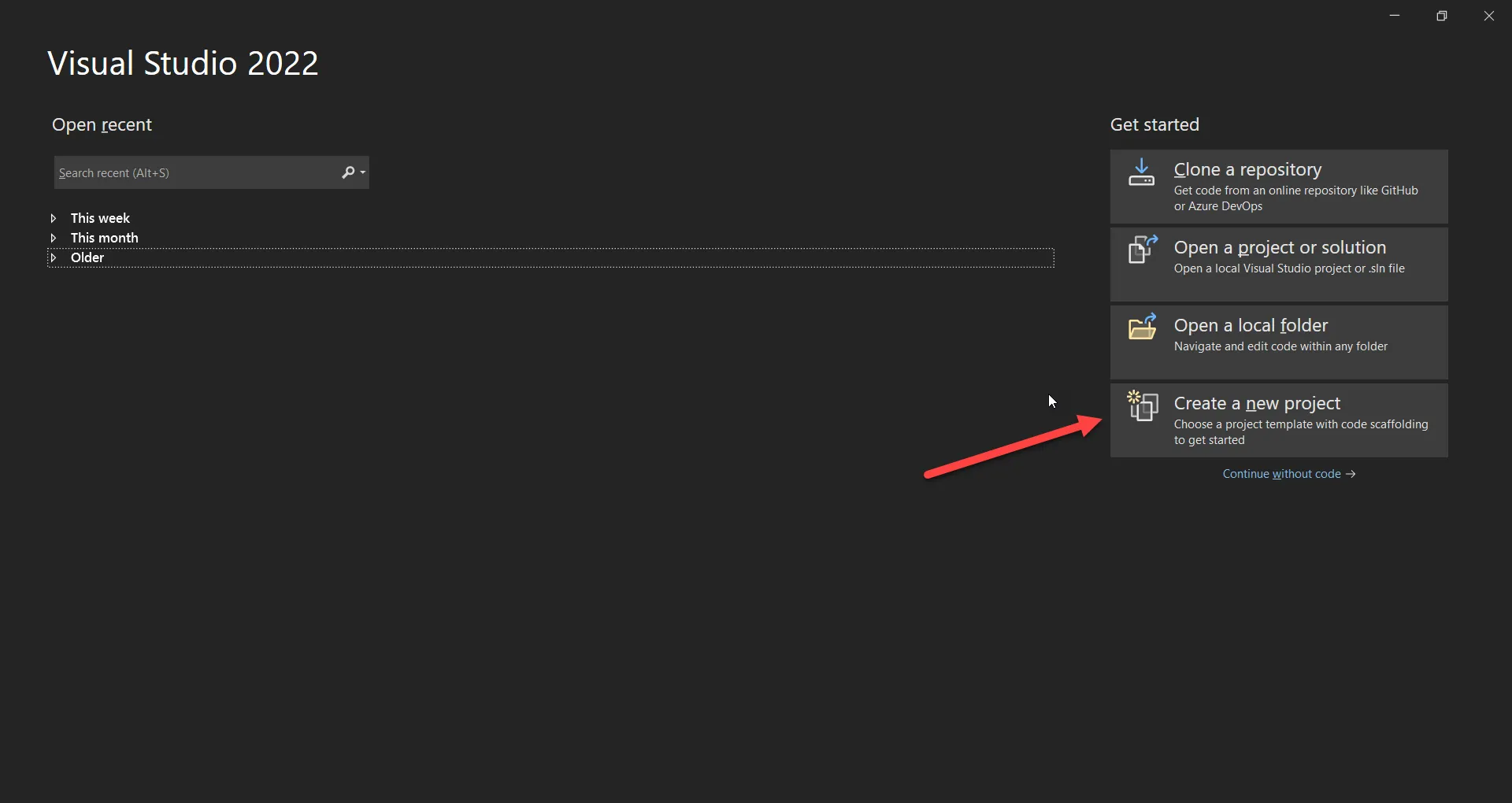 Create a new project in Visual Studio
Create a new project in Visual Studio
- Search for "Console" in the search field, and select "Console App" with C# tag from the search results.
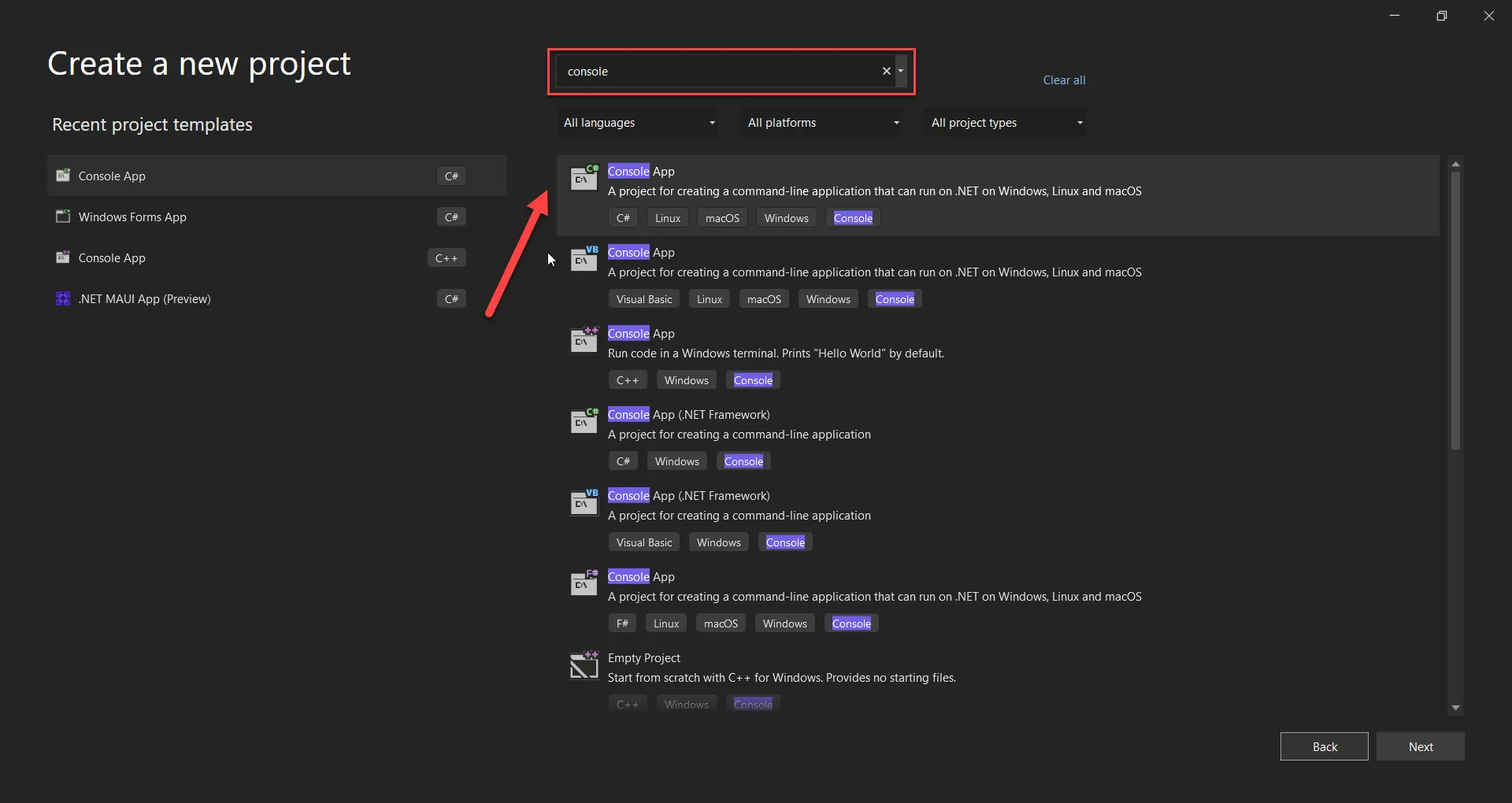 Console App selection
Console App selection
- After that, configure the project name according to your requirements.
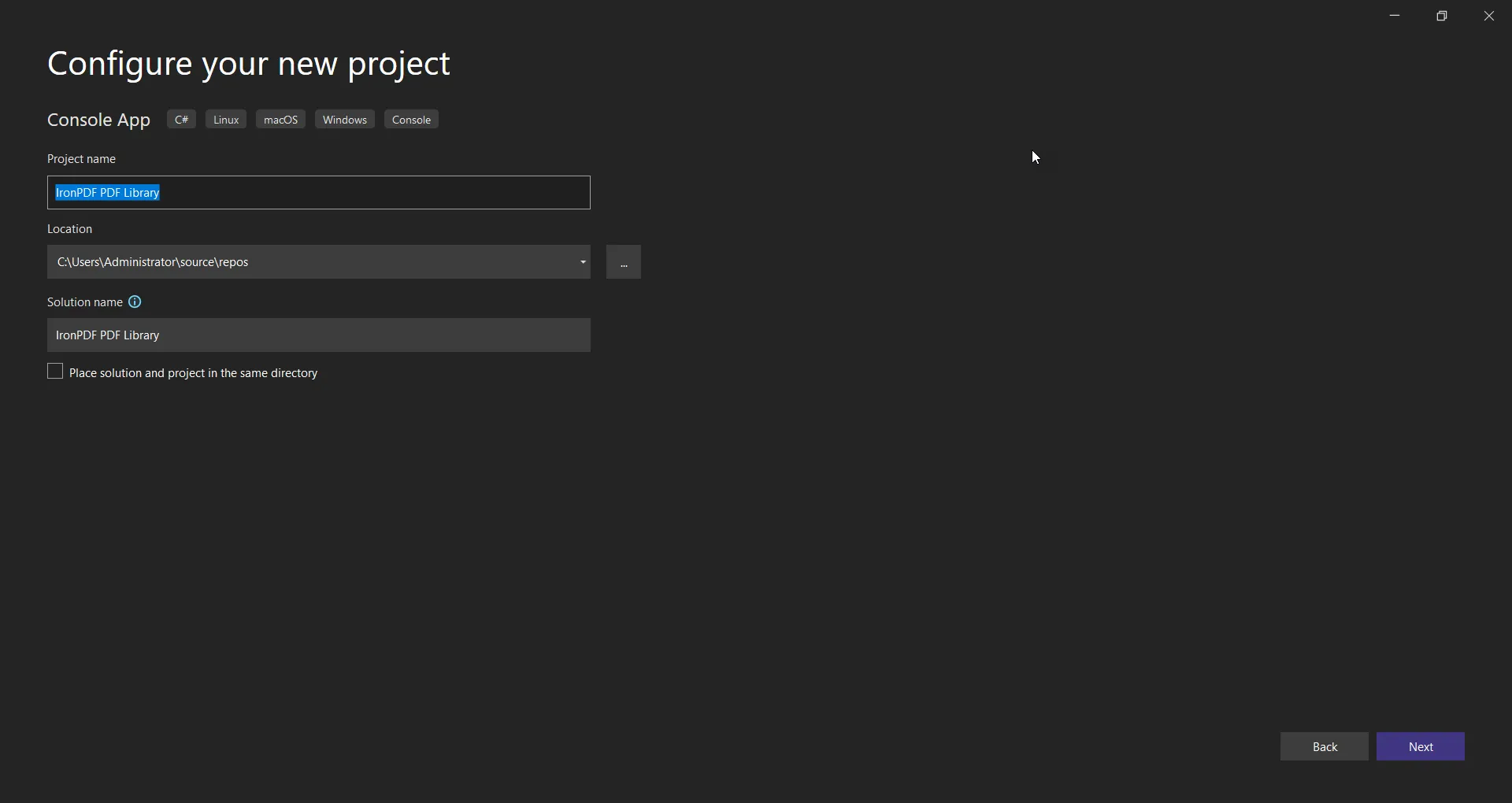 Configure this new application
Configure this new application
- After that, select the latest version of .NET Framework from the dropdown list. This is recommended. Next, click on the Create button.
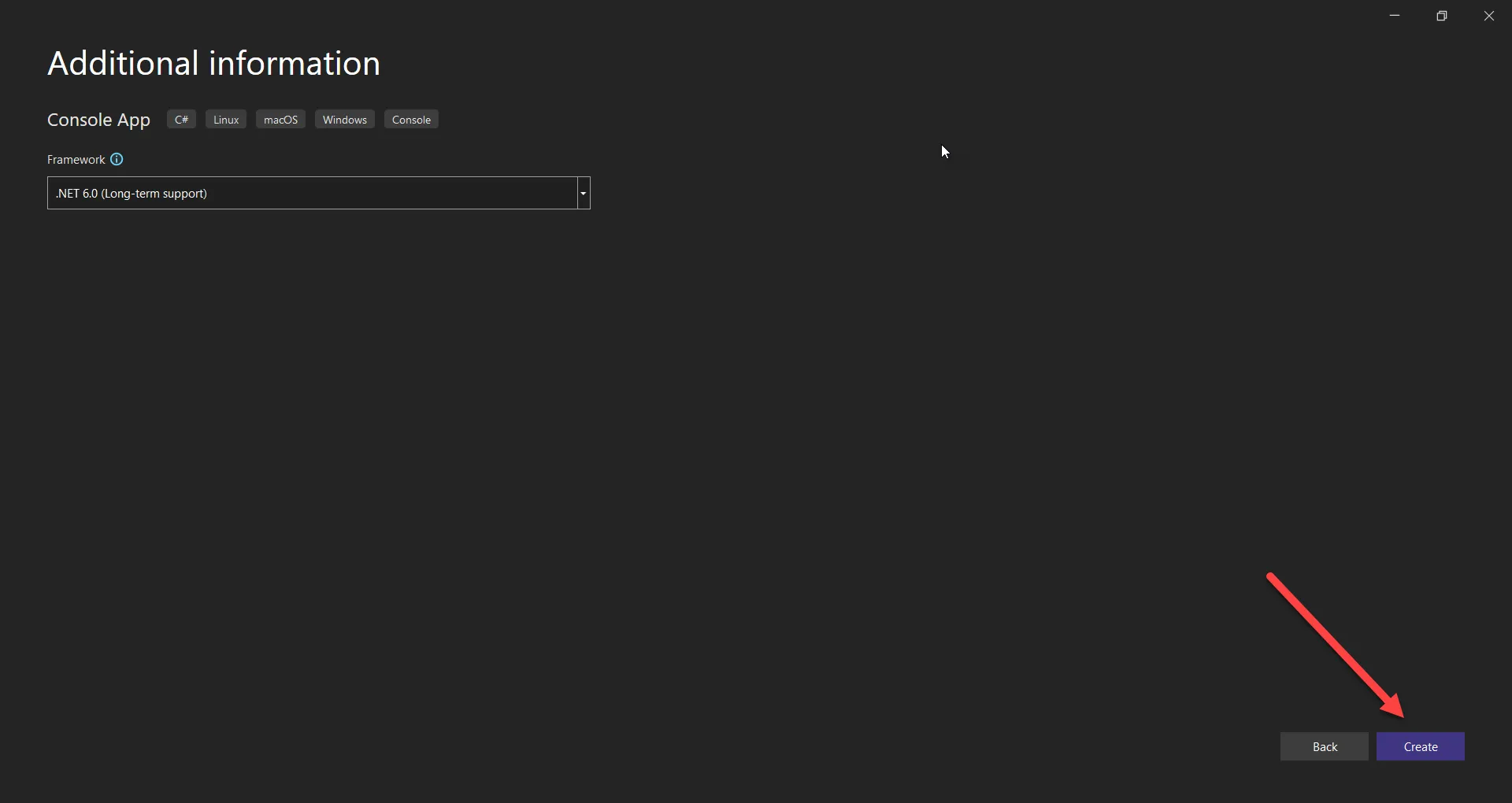 .NET Framework selection
.NET Framework selection
The project will now be created. You can also use existing .NET Core projects with IronPDF. First, you need to install the library. The next section shows how to install the library.
Installation of the IronPDF Library
The IronPDF library can be installed from the console. Simply write the following line of code in the console and hit Enter.
Install-Package IronPdf
You can get more information on the IronPDF website and the IronPDF NuGet website.
After installation, you will be able to use it in your .NET project. For more details about installation, visit the IronPDF website.
Code Example
A web page for PDF files
using IronPdf;
var renderer = new ChromePdfRenderer();
//Choose Screen or Print CSS media
renderer.RenderingOptions.CssMediaType = Rendering.PdfCssMediaType.Screen;
//Set the width of the responsive virtual browser window in pixels
renderer.RenderingOptions.ViewPortWidth = 1280;
renderer.RenderingOptions.PaperSize = Rendering.PdfPaperSize.A2;
var pdf = renderer.RenderUrlAsPdf("https://www.amazon.com/");
pdf.SaveAs("Amazon.pdf");using IronPdf;
var renderer = new ChromePdfRenderer();
//Choose Screen or Print CSS media
renderer.RenderingOptions.CssMediaType = Rendering.PdfCssMediaType.Screen;
//Set the width of the responsive virtual browser window in pixels
renderer.RenderingOptions.ViewPortWidth = 1280;
renderer.RenderingOptions.PaperSize = Rendering.PdfPaperSize.A2;
var pdf = renderer.RenderUrlAsPdf("https://www.amazon.com/");
pdf.SaveAs("Amazon.pdf");Imports IronPdf
Private renderer = New ChromePdfRenderer()
'Choose Screen or Print CSS media
renderer.RenderingOptions.CssMediaType = Rendering.PdfCssMediaType.Screen
'Set the width of the responsive virtual browser window in pixels
renderer.RenderingOptions.ViewPortWidth = 1280
renderer.RenderingOptions.PaperSize = Rendering.PdfPaperSize.A2
Dim pdf = renderer.RenderUrlAsPdf("https://www.amazon.com/")
pdf.SaveAs("Amazon.pdf")This example shows how to convert a complex website UI to PDF, for example: the Amazon website, following those steps:
- Set the Media Type to the Screen
- Set the viewport width
- Set the paper size of the output PDF. Page size is a significant factor in PDF files
- Render the URL to PDF, with the source from Amazon URL.
Output
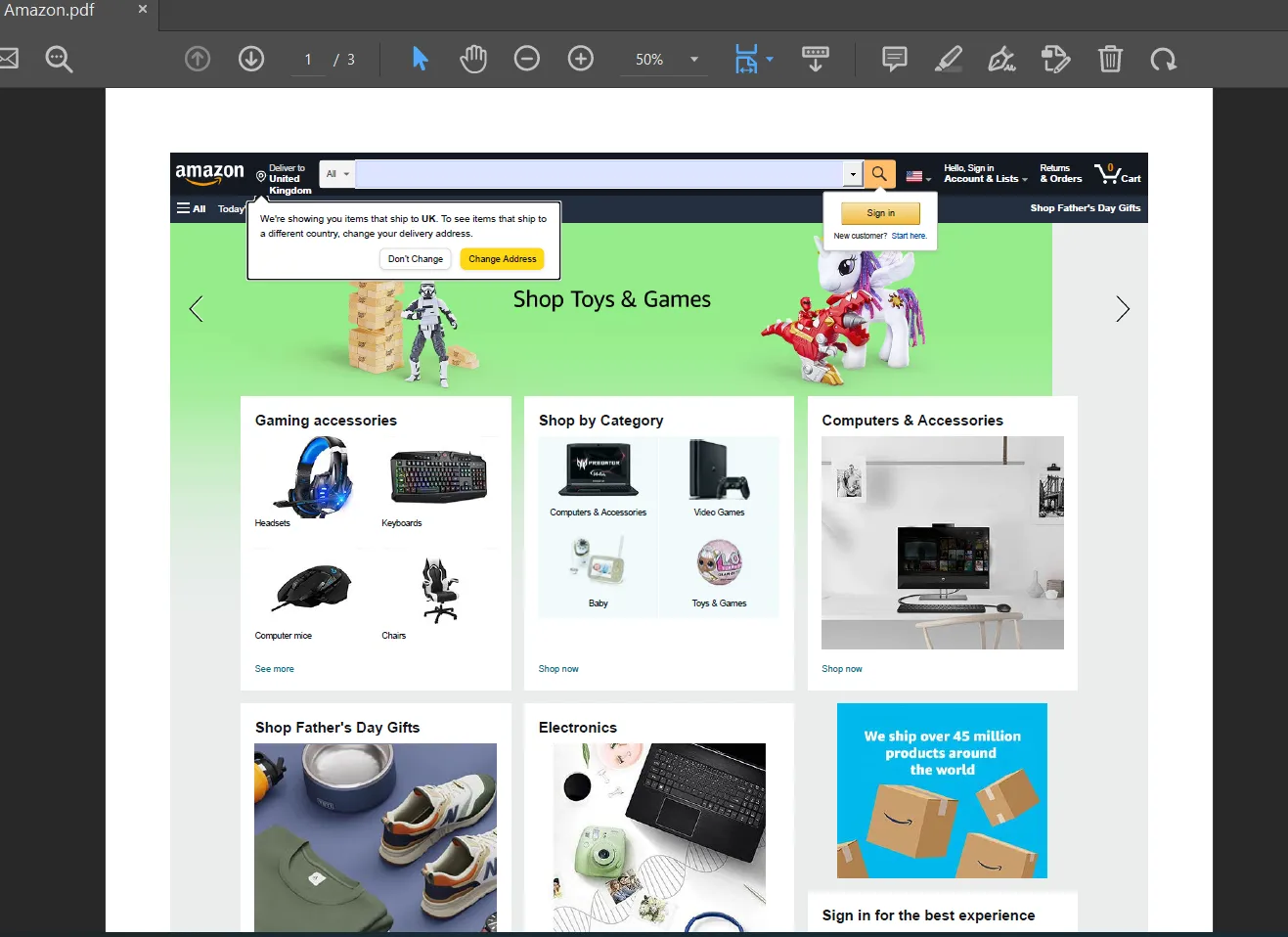 Output PDF file rendered from Amazon website
Output PDF file rendered from Amazon website
Simple PDF Creation
using IronPdf;
// Instantiate renderer
var renderer = new IronPdf.ChromePdfRenderer();
// Create a PDF from a HTML string using C#
using var pdf = renderer.RenderHtmlAsPdf("<h1>Hello World</h1>");
// Export to a file or Stream
pdf.SaveAs("output.pdf");
/****** Advanced Example with HTML Assets ******/
// Load external html assets: images, CSS and JavaScript.
// An optional BasePath 'C:\site\assets\' is set as the file location to load assets from
using var myAdvancedPdf = renderer.RenderHtmlAsPdf("<img src='icons/iron.png'>", @"C:\site\assets\");
pdf.SaveAs("html-with-assets.pdf");using IronPdf;
// Instantiate renderer
var renderer = new IronPdf.ChromePdfRenderer();
// Create a PDF from a HTML string using C#
using var pdf = renderer.RenderHtmlAsPdf("<h1>Hello World</h1>");
// Export to a file or Stream
pdf.SaveAs("output.pdf");
/****** Advanced Example with HTML Assets ******/
// Load external html assets: images, CSS and JavaScript.
// An optional BasePath 'C:\site\assets\' is set as the file location to load assets from
using var myAdvancedPdf = renderer.RenderHtmlAsPdf("<img src='icons/iron.png'>", @"C:\site\assets\");
pdf.SaveAs("html-with-assets.pdf");Imports IronPdf
' Instantiate renderer
Private renderer = New IronPdf.ChromePdfRenderer()
' Create a PDF from a HTML string using C#
Private pdf = renderer.RenderHtmlAsPdf("<h1>Hello World</h1>")
' Export to a file or Stream
pdf.SaveAs("output.pdf")
'''**** Advanced Example with HTML Assets *****
' Load external html assets: images, CSS and JavaScript.
' An optional BasePath 'C:\site\assets\' is set as the file location to load assets from
Dim myAdvancedPdf = renderer.RenderHtmlAsPdf("<img src='icons/iron.png'>", "C:\site\assets\")
pdf.SaveAs("html-with-assets.pdf")The code above demonstrates how to use the HTML-to-PDF functionality of IronPDF. To use IronPDF, importing the namespace is necessary. Write using IronPdf; at the top of the program file to use it in the project.
The ChromePdfRenderer object is provided for web support. The RenderHtmlAsPdf function can be used for converting HTML strings to PDF files. The function parameter accepts various types of sources, including an HTML string. You can also use images in your PDF document by setting the base path of images. After that, the SaveAs function is used to save the PDF file on the local machine. You can choose simple HTML like the above and incorporate CSS, images, and JavaScript.
Output
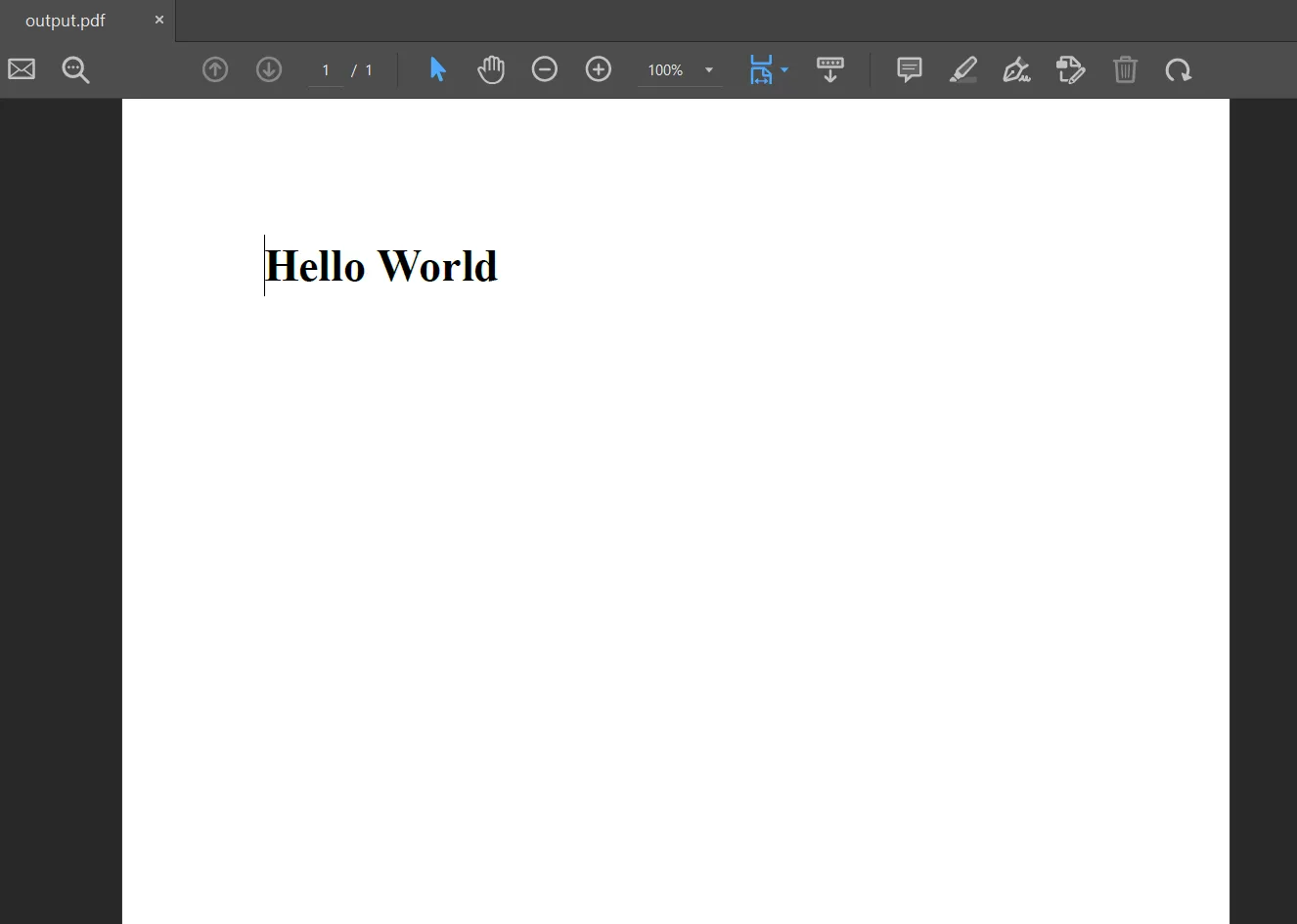 PDF file output from Hello World HTML text
PDF file output from Hello World HTML text
Headers & Footers
renderer.RenderingOptions.FirstPageNumber = 1; // use 2 if a coverpage will be appended
renderer.RenderingOptions.TextHeader.DrawDividerLine = true;
renderer.RenderingOptions.TextHeader.CenterText = "{url}";
renderer.RenderingOptions.TextHeader.Font = IronPdf.Font.FontTypes.Helvetica;
renderer.RenderingOptions.TextHeader.FontSize = 12;renderer.RenderingOptions.FirstPageNumber = 1; // use 2 if a coverpage will be appended
renderer.RenderingOptions.TextHeader.DrawDividerLine = true;
renderer.RenderingOptions.TextHeader.CenterText = "{url}";
renderer.RenderingOptions.TextHeader.Font = IronPdf.Font.FontTypes.Helvetica;
renderer.RenderingOptions.TextHeader.FontSize = 12;renderer.RenderingOptions.FirstPageNumber = 1 ' use 2 if a coverpage will be appended
renderer.RenderingOptions.TextHeader.DrawDividerLine = True
renderer.RenderingOptions.TextHeader.CenterText = "{url}"
renderer.RenderingOptions.TextHeader.Font = IronPdf.Font.FontTypes.Helvetica
renderer.RenderingOptions.TextHeader.FontSize = 12The above example demonstrates how to set headers and footers in the PDF file. IronPDF supports repeating headers in the document. IronPDF gives TextHeader and TextFooter properties to set the multiple properties of text, such as fonts, text position, etc. It can also convert HTML files to PDF files. It is all straightforward with IronPDF. It can also merge PDF files, perform webpage-to-PDF, enable automatic page numeration, and make digital signatures using IronPDF. Further, it produces PDF files of minimal file size with compression.
Summary
IronPDF is a complete PDF library that supports all the latest versions of .NET Core and .NET Frameworks. IronPDF is based on a business model that offers a secure way to create and edit business documents using the IronPDF library. Its advanced features enable the user to create dynamic and creative PDF documents in .NET Core projects.
The free version of IronPDF is entirely free for developers. You can use it for development purposes for free with a watermark. There is also the option to try the free trial for production testing.
 IronPDF Professional license
IronPDF Professional license
You can also currently buy the suite of five Iron Software packages for the price of just two. Get more information from the IronPDF website.











